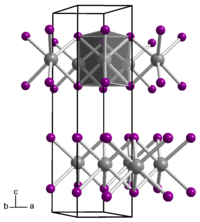Gadolinium diiodide
| Crystal structure | |||||||
|---|---|---|---|---|---|---|---|

|
|||||||
| __ Gd 2+ __ I - | |||||||
| General | |||||||
| Surname | Gadolinium diiodide | ||||||
| other names |
Gadolinium diiodide |
||||||
| Ratio formula | GdI 2 | ||||||
| Brief description |
bronze colored solid |
||||||
| External identifiers / databases | |||||||
|
|||||||
| properties | |||||||
| Molar mass | 411.06 g mol −1 | ||||||
| Physical state |
firmly |
||||||
| Melting point |
831 ° C |
||||||
| safety instructions | |||||||
|
|||||||
| As far as possible and customary, SI units are used. Unless otherwise noted, the data given apply to standard conditions . | |||||||
Gadolinium diiodide is an inorganic chemical compound of gadolinium from the group of iodides .
Extraction and presentation
Gadolinium diiodide can be obtained by reducing gadolinium (III) iodide with gadolinium in a vacuum at 800 ° C to 900 ° C.
It can also be represented by the reaction of gadolinium with mercury (II) iodide .
properties
Gadolinium diiodide is an opaque, dark, compact solid with a strong gloss and a metal-like appearance and character. Therein gadolinium is trivalent according to Gd 3+ (I - ) 2 e - . The connection is extremely hygroscopic and can only be stored and handled under carefully dried protective gas or in a high vacuum. In air it changes into hydrates with moisture absorption , but these are unstable and more or less quickly turn into oxide iodides with evolution of hydrogen . These processes take place much faster with water. The compound has a crystal structure of the 2H molybdenum (IV) sulfide type.
Individual evidence
- ^ A b William M. Haynes: CRC Handbook of Chemistry and Physics, 93rd Edition . CRC Press, 2012, ISBN 1-4398-8049-2 , pp. 4–64 ( limited preview in Google Book Search).
- ↑ a b c d Georg Brauer (Ed.), With the collaboration of Marianne Baudler a . a .: Handbook of Preparative Inorganic Chemistry. 3rd, revised edition. Volume I, Ferdinand Enke, Stuttgart 1975, ISBN 3-432-02328-6 , p. 1081.
- ↑ This substance has either not yet been classified with regard to its hazardousness or a reliable and citable source has not yet been found.
- ↑ Ralf Alsfasser, Erwin Riedel: Modern Inorganic Chemistry . Walter de Gruyter, 2007, ISBN 3-11-019060-5 , p. 366 ( limited preview in Google Book search).

